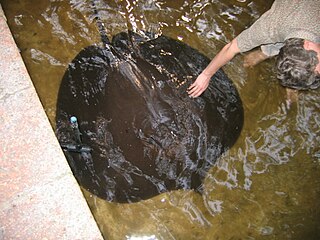- Extinct in the wild (EW): 6 species
- Critically endangered (CR): 455 species
- Endangered (EN): 643 species
- Vulnerable (VU): 1,245 species
- Near threatened (NT, LR/cd): 548 species
- Least concern (LC): 9,131 species
- Data deficient (DD): 3,191 species
- 15,219 extant species have been evaluated
- 12,028 of those are fully assessed [lower-alpha 1]
- 9679 are not threatened at present [lower-alpha 2]
- 2343 to 5534 are threatened [lower-alpha 3]
- 71 to 158 are extinct or extinct in the wild:
- 65 extinct (EX) species [lower-alpha 4]
- 6 extinct in the wild (EW)
- 87 possibly extinct [CR(PE)]
- 0 possibly extinct in the wild [CR(PEW)]
- ↑ excludes data deficient evaluations.
- ↑ NT, LR/cd, LC.
- ↑ Threatened comprises CR, EN and VU. Upper estimate additionally includes DD.
- ↑ Chart omits extinct (EX) species

In September 2016, the International Union for Conservation of Nature (IUCN) listed 1245 vulnerable fish species. [1] Of all evaluated fish species, 8.1% are listed as vulnerable. The IUCN also lists eight fish subspecies as vulnerable.
Contents
- Lobe-finned fishes
- Cartilaginous fishes
- Angelsharks
- Mackerel sharks
- Rays and skates
- Ground sharks
- Carpet sharks
- Squaliformes
- Chimaeras
- Lampreys
- Ray-finned fishes
- Acipenseriformes
- Salmoniformes
- Silversides
- Toothcarps
- Cypriniformes
- Gasterosteiformes
- Osmeriformes
- Catfishes
- Batrachoidiformes
- Perciformes
- Beloniformes
- Synbranchiformes
- Osteoglossiformes
- Gobiesociformes
- Characiformes
- Syngnathiformes
- Clupeiformes
- Scorpaeniformes
- Ophidiiformes
- Tetraodontiformes
- Other ray-finned fish species
- Hagfishes
- See also
- References
Of the subpopulations of fishes evaluated by the IUCN, 18 species subpopulations have been assessed as vulnerable.
For a species to be assessed as vulnerable to extinction the best available evidence must meet quantitative criteria set by the IUCN designed to reflect "a high risk of extinction in the wild". Endangered and critically endangered species also meet the quantitative criteria of vulnerable species, and are listed separately. See: List of endangered fishes, List of critically endangered fishes. Vulnerable, endangered and critically endangered species are collectively referred to as threatened species by the IUCN.
Additionally 3191 fish species (21% of those evaluated) are listed as data deficient, meaning there is insufficient information for a full assessment of conservation status. As these species typically have small distributions and/or populations, they are intrinsically likely to be threatened, according to the IUCN. [2] While the category of data deficient indicates that no assessment of extinction risk has been made for the taxa, the IUCN notes that it may be appropriate to give them "the same degree of attention as threatened taxa, at least until their status can be assessed." [3]
This is a complete list of vulnerable fish species and subspecies evaluated by the IUCN. Species and subspecies which have vulnerable subpopulations (or stocks) are indicated.




